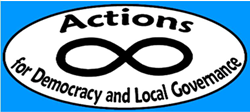Our Approach
Programatic Approach of ADLG
Vision
• A credible and capable institution for Capacity Building and Advocacy in Democracy, Leadership and Local Governance through strong and sustainable partnership with various stakeholders.
Mission
• To promote and advance the cause of Democracy, Good Governance and increased citizen participation in Democracy and Governance related matters through civic education, advocacy and community mobilization/animation.
Our goal:
• Create and enhance abilities of young people, men and women, teachers and religious leaders in mining, farming and fishing communities to actively engage in democratic governance agenda at village, ward and district levels.
Our strategy:
• Through Community Animation, where we enhance Capacity Development through participatory training approaches, mentoring and dialogues to challenge practices, promote individual innovations, reflections and critical thinking towards inspiring citizens to take collective decisive actions to influence national and local policy processes.
Specific Objectives
Four specific objectives were developed in 2011 to guide ADLG in interventions:
• To develop acceptable models for applied local governance, local democracy and local participation and build ADLG as a reliable institution for citizen engagement model.
• To enhance special groups of people i.e. children, youth, poor and marginalized women, people with disability, people living with HIV/AIDS to engage strategically in matters related to Democracy and Governance.
• To collaborate with other CSOs for effective national advocacy and lobbying on public resource management and informed civil populace.
• To promote popular education theories and acceptable practices of democracy, leadership and governance to rural fishing, mining and farming communities.
Animation is our intervention approach
“Animation” as an approach, is built on notion that Tanzanians shall realize their innate potential for improving their lives through inclusive and participatory democracy where a collective action is a result of involvement of all members of a community.
This approach is largely influenced by the readings of Paulo Freire’s “Pedagogy of the oppressed” that consider
“conscientization” shall develop through a process of community discussions, reflection and finally (community
members) taking actions.
“Community animators,” are individuals, trained to be active citizens who use knowledge and skills in dealing with issues related to social justice, they facilitate the process of discovering how individuals and groups can be part of transformation. These are positioned to strengthen the demand side of accountability, they work with other members in the community to hold local governments to account, and they seek to enhance justice, accountability, democracy and governance.
They challenge “fear” in communities, they ask questions and seek answers about natural resources, allocations, public policies, leadership practices and about access, quality and equity in public service delivery processes. They serve as examples by monitoring public resources including village finances, service levies and other locally generated money, they actively participate in village, district and regional level gatherings/meetings.
Through mentoring and coaching, animators have also been at a forefront actively supporting the three rural communities to engage in constitution-making process.
Areas we practice the “animation” approach
Now, the approach is implemented in 170 villages of the eight districts of Kishapu, Shinyanga rural, Kahama, Bukombe, Mbogwe, Maswa, Itilima and Bariadi, Ukerewe and Magu where ADLG works with a network of 408 community animators (farmers, teachers, and religious leaders). Over the past two years, the animation approach has managed to support communities to take collective actions on issues related to land grabbing, village plans and finances, women’s health, livestock development, domestic violence, large scale investments and corporate social responsibility, compensation, corruption, access to safe water and quality education.
As we implement the community animation strategy, cotton farming became a concern of majority cotton growers in Kahama, Maswa, Kishapu and Bariadi areas, there is fear that cotton farming is being sabotaged and that growers are being exploited by some investors who have created a syndicate with some politicians. ADLG is working with stakeholders to stimulate the institutions of governance around the cotton farming.
ADLG is working with ANSAF to help cotton growers to claim compensation from government after cotton seeds failed to grow in 2013/14 season. We have conducted several dialogues in three districts so far, we look forward to conduct national dialogues with key ministers and members of the parliament on the matter in future. ADLG is implementing Social Accountability Monitoring (SAM) in Sengerema and Bariadi on agriculture
Since the beginning of ADLG’s work with animators, mining has come up as an issue and concern for various communities across the regions. Whereas initially this was largely restricted to the areas where there were large-scale investments in mining, e.g. Mwadui in Kishapu and Buzwagi in Kahama, it is no longer so the case. Communities have raised concerns around both small-scale and large-scale mining, on access to land and water in the face of mining and prospecting, and on compensation and CSR. ADLG is looking forward to conduct SAM in mining sector.
How we learn
Learning continues to be central to ADLG, and continues to be a regular component of all activities within the programmes. On-going monitoring continues using the Outcome mapping journals (Outcome Mapping is an innovative approach to project and programme planning, monitoring and evaluation with a strong focus on participatory learning. The major innovation is the emphasis on the behaviour change of key actors with whom the programme has an influence, rather than focussing on changes in state that may or may not be attributed to the programme.), which feeds into the program /project planning and reporting.
To supplement, sometimes ad-hoc data coming out of the outcome mapping journals, the programme relies more on supplementary information from “story telling” which are generated from mentoring sessions (mostly during field visits), and telephone conversations. Stories are often powerful pieces of truth and storytelling is one of the most effective ways to convey them especially in society where there little motivation for reading and writing.

